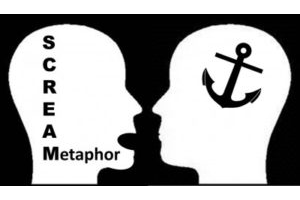“The greatest thing by far is to be a master of metaphor.” –Aristotle
Metaphor is the last rhetorical device in the acronym SCREAM (Simile, Contrast, Rhyme, Echo, Alliteration, and Metaphor). Metaphor is the comparison of two UNLIKE things without using the word “like” as in a simile. In a previous post, I briefly explained the difference between similes and metaphors. A metaphor is a substitution. With a metaphor you say that one thing is another thing, as in “Jack is a pig.” Of course, Jack is not literally a pig; he just acts like one–greedy, dirty or gross*.
Metaphors usually link something that is tangible that we can physically sense (see, touch, hear, smell or taste) with an intangible concept. A metaphor can be a powerful shortcut to meaning, helping people see something in a new way. Metaphors and the other figures of speech in SCREAM will anchor your points in your listeners’ minds. (Note the use of “anchor” as a metaphor).
Steps to Creating Your Own Metaphors
1. Decide on the mood you want to convey, but don’t be too specific just yet. Pick a basic emotion:
Anger, fear, disgust, contempt, joy, sadness, surprise
2. Ask yourself, does this remind me of something from my childhood? Another experience? Is there some outstanding characteristic? Jot down whatever comes to mind.
3. Within the “mood” constraints, brainstorm by asking yourself 5-sense questions to make a concept more concrete. Go for quantity over quality at this point:
a. What does it look like? (Visual impact is paramount in presentations. Go for greatest quantity here. You want VIVID images).
b. What does it sound like?
c. What does it feel like?
d. What does it taste like?
e. What does it smell like?
4. Draw it out. If finding a metaphor is difficult, try drawing pictures to loosen up your creativity.
5. Remove “like” or “as” to switch from a simile to a metaphor. Does it have more power without the like or as? (Compare “you are like my sunshine” to “You are my sunshine.”)
6. Say it out loud. Say the possible metaphors out loud to hear how they sound. What looks good on paper doesn’t always sound good.
An example:
Next month, I will be presenting “Networking for Effective Engagement” at the Minnesota School Nutrition Association Conference. I’d like to come up with a metaphor for “walking into a room full of strangers.”
Here’s my attempt at going through the first 4 steps:
1. Basic Emotion: Fear
2. Memories: First day of kindergarten, going to husband’s office party
3. Sense questions:
a. What does it look like? A Chinese buffet with lots of strange foods. Or, a school cafeteria with lots of selections and limited time.
b. What does it sound like? Rumble of an approaching storm
c. What does it feel like? New clothes on the first day of school (uncomfortable, unfamiliar, but good-looking)
d. What does it taste like? Kimchi, the first time I ate it. Vitamins—not the kiddie ones.
e. What does it smell like? Kimchi. . . (I now like Kimchi, Korean spicy, fermented cabbage, but it really has a strong odor.)
4. Draw it out—When I drew out a simple representation of people at a networking event, I made circles and it reminded me of “connect the dots.” So, a networking event is a huge connect-the-dot activity, but with strangers, you don’t know where to start or what connections to make.
I’d probably have to spend more than the five minutes I just spent to come up with some better ones, but now that I’m thinking about it, my mind will be open to ideas. Got a good one? I’d love to hear from you.
Add metaphors to your speaking tool kit and tap into your listeners’ minds!
*Pigs, unfortunately, have a bad reputation.

